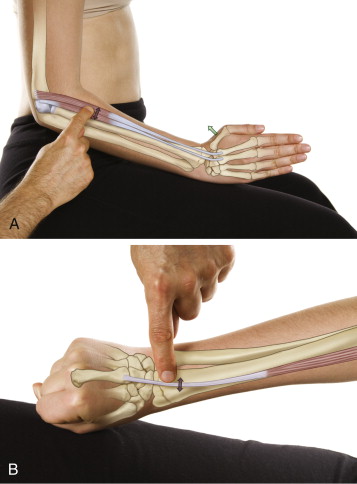Tennis Elbow – Introduction

A, Palpation of the belly of the extensor carpi radialis brevis. B, Making a fist requires isometric engagement of the extensor carpi radialis brevis to stabilize the hand from flexing at the wrist joint. Permission: Joseph E. Muscolino, The Muscle and Bone Palpation Manual, 2ed. (2016), Elsevier.
Tennis elbow is the term given to the condition that involves inflammation or degeneration of the common extensor belly/tendon of the posterior forearm and/or inflammation of its lateral epicondyle attachment on the humerus (the outside of the elbow). For this reason, tennis elbow is also known as lateral epicondylitis or lateral epicondylosis. The term lateral epicondylitis is applied when swelling is present (itis means swelling); lateral epicondylosis is applied when swelling is no longer present and the tendon begins to degenerate instead (osis is a general term for condition). Tennis elbow is so named because playing tennis is often the cause of this condition.
Note: Golfer’s elbow (see blog post series on golfer’s elbow) is a similar condition of the muscles/tendons (myofascial tissue) of the common flexor tendon at the medial epicondyle of the humerus.
Causes of tennis elbow
Even though playing tennis can cause tennis elbow, it is not necessary to play tennis to have this condition. Effectively, the cause of tennis elbow is any overuse of the muscles that contribute to the common extensor tendon. These muscles are the extensor carpi radialis brevis, extensor digitorum, extensor digiti minimi, and the extensor carpi ulnaris. As evident in their names, these muscles create extension of the hand at the wrist joint as well as extension of the fingers. Therefore, excessive postures and activities that engage wrist and finger extension can potentially cause this condition.
If playing tennis is the cause of tennis elbow, it is usually the backhand stroke that is involved. When hitting this stroke, the wrist joint should stay in neutral position and not extend. If someone has improper form and instead extends the hand at the wrist joint during the stroke, it engages and therefore stresses the muscles of the common extensor tendon. However, even if the player maintains the hand in the proper neutral position, it is still possible to develop tennis elbow because maintaining a neutral wrist position when striking the ball still requires contraction of the muscles of wrist extension. But instead of contracting concentrically, they contract isometrically to stabilize the hand at the wrist joint against the force of the ball striking the racquet, which would cause the wrist joint to flex. Therefore, if a player plays against someone who hits more forcefully than they are used to, and/or if the player plays for longer than they are used to, the muscles and their common tendon may be overused and injured.
Of course, tennis is not the only activity that requires finger and wrist extension. Other examples include working at a check out counter, a carpenter or other manual laborer using and swinging a tool, a musician playing an instrument, or even a manual therapist working on clients/patients.
However, if extension of the wrist and fingers were the only cause of tennis elbow, this condition would not occur as often as it does. There is another activity that is a major contributor to tennis elbow that many therapists do not realize. That is flexing the fingers to grip an object. To flex the fingers, we engage the flexor digitorum superficialis, flexor digitorum profundus, and the flexor pollicis longus muscles. However, when these muscles contract to flex the fingers, they also create a pulling force that flexes the hand at the wrist joint. To stabilize the wrist joint and prevent it from flexing, we need to isometrically contract extensor musculature of the wrist. The muscle that is most commonly engaged for this function is the extensor carpi radialis brevis. If you observe and palpate the posterior wrist slightly lateral/radial to the midline when making a fist, you can usually see and feel the distal tendon of the extensor carpi radialis brevis contract and tauten. Therefore, extended periods of time spent gripping an object can lead to tennis elbow. Examples abound: gripping a tool such as a hammer or screwdriver, holding the steering wheel of a car, gripping a tennis racquet when hitting a backhand or forehand, gripping a pen or pencil when writing, or simply holding a cell (mobile) phone. Given how often we hold/grip objects, it is easy to see why tennis elbow is such a common condition.
In addition to repeated microtraumatic overuse of the muscles of the common extensor tendon, a direct physical macrotrauma to the common extensor tendon or the lateral epicondyle of the humerus, such as a bang, fall, or sudden powerful overstretch of the associated musculature can also contribute to tennis elbow.
Click here for an article on the causes of golfer’s elbow.
Note: This is the first of five blog post articles on tennis elbow.
The five articles are:
- What are the causes of Tennis Elbow?
- What are the signs and symptoms of Tennis Elbow?
- How do we assess (diagnose) Tennis Elbow?
- How do we treat Tennis Elbow with manual therapy?
- What are the self-care and medical approaches to Tennis Elbow?


